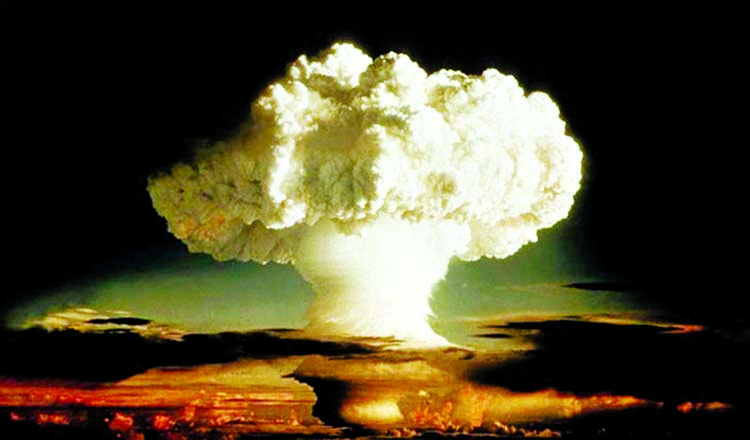
USA Today :
North Korea’s state-run broadcaster said Sunday the country had successfully conducted a test of a hydrogen bomb that can be loaded onto its new intercontinental ballistic missiles.
The nuclear test was estimated to have a strength of 100 kilotons, according to South Korea’s Yonhap News Agency, citing South Korean lawmaker Kim Young-woo, chief of the parliament’s defense committee.
That yield would be five-to-10 times more powerful than North Korea’s previous test in 2016 – and about five times the power of the bomb dropped on Nagasaki, Japan, in World War II.
There was no immediate confirmation outside North Korea that the test involved a hydrogen bomb, or that it could be loaded onto a missile. Pyongyang has made similar boasts after past tests that were disputed by the United States and other experts in the West.
The latest test, however, appears to mark a significant step forward in the North’s quest for a viable nuclear missile capable of striking anywhere in the United States.
President Trump responded with a series of tweets. calling North Korea a “rogue nation” and saying its “words and actions continue to be very hostile and dangerous to the United States.”
“South Korea is finding, as I have told them, that their talk of appeasement with North Korea will not work, they only understand one thing!” Trump tweeted.
South Korea said a 20-minute emergency phone call took place with U.S. national security adviser H.R. McMaster and his South Korean counterpart, Chung Eui-yong, about an hour after the detonation.
Moon will seek further diplomatic means to “completely isolate” North Korea, Chung said at a news briefing. Chung also said Seoul would discuss with Washington the possible deployment of “the most powerful U.S. strategic military assets to South Korea.”
On North Korean television, a news reader called the test a “complete success” and said the “two-stage thermonuclear weapon” had “unprecedented” strength. Hours earlier, Pyongyang claimed leader Kim Jong Un had inspected a hydrogen bomb meant for a new intercontinental ballistic missile.
China’s foreign ministry released a statement saying “the Chinese government expresses its strong opposition and strongly condemns” the test, urging North Korea to abide by the resolutions of the United Nations Security Council. Russia’s Foreign Ministry also condemned the test, as did Britain, Italy and the leaders of NATO and the European Union.
The Japanese government also confirmed that the tremors were caused by a nuclear test, Foreign Minister Taro Kono said after a meeting of Japan’s National Security Council. Japanese Prime Minister Shinzo Abe condemned the reported hydrogen bomb test.
“It is absolutely unacceptable if North Korea did force another nuclear test, and we must protest strongly,” Abe said, according to the Associated Press.
U.S. Geological Survey data showed that a magnitude-6.3 seismic event was detected Sunday in North Hamgyeong Province. Later, the the geological survey said a magnitude-4.1 event was recorded eight minutes after the initial quake, “possibly a structural collapse” caused by the larger seismic event.
The recorded seismic event came hours after North Korea claimed it had developed a hydrogen bomb that could be mounted on its intercontinental ballistic missiles. Photos from North Korea’s state-run Korean Central News Agency showed Kim viewing what news agency said was a hydrogen bomb.
KCNA claimed the hydrogen bomb has “great destructive power which can be detonated even at high altitude,” and that all the components of the hydrogen bomb were “homemade.”
North Korean media claims it has an advanced nuclear weapon with ‘great destructive power.’ According to reports, North Korea’s leader Kim Jong-Un has inspected a hydrogen bomb intended to be loaded on a new intercontinental ballistic missile.
Analysts said Sunday’s test indicates that North Korea is getting close to posing a credible nuclear threat to the U.S.
“This looks like a major improvement in yield and the two-stage nature of the test supports the idea it was a test of a thermonuclear device,” said Chad O’Carroll, CEO and founder of Seoul-based Korea Risk Group, a risk advisory firm specializing in North Korea.
“If, as North Korea says, the Hwasong-14 intercontinental ballistic missile can now be equipped with a thermonuclear device like the one tested today, it means the North is very close to being able to deploy credible battle-ready nuclear weapons that can target the U.S,” O’Carroll added.
Last September, North Korea conducted its fifth nuclear test, showing its determination to be a nuclear-armed country despite ever tougher sanctions. The test drew a strong rebuke from ally China, which said it would protest the test with North Korea’s ambassador in Beijing.
North Korea flew a Hwasong-12 over northern Japan last week, the first such overflight by a missile capable of carrying nukes, in a launch that Kim described as a “meaningful prelude” to containing Guam, the home of major U.S. military facilities, and more ballistic missile tests targeting the Pacific.
O’Carroll said he expects North Korea to soon launch a new test of an intercontinental ballistic missile (ICBM) with a long-range trajectory of thousands of miles into the Pacific Ocean.
“If one or two more ICBMs can be tested successfully in this way, North Korea would then announce the battle-ready deployment of its ICBM force,” he said.

